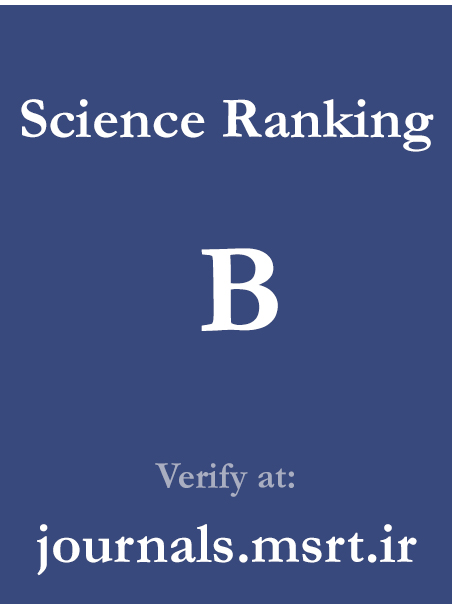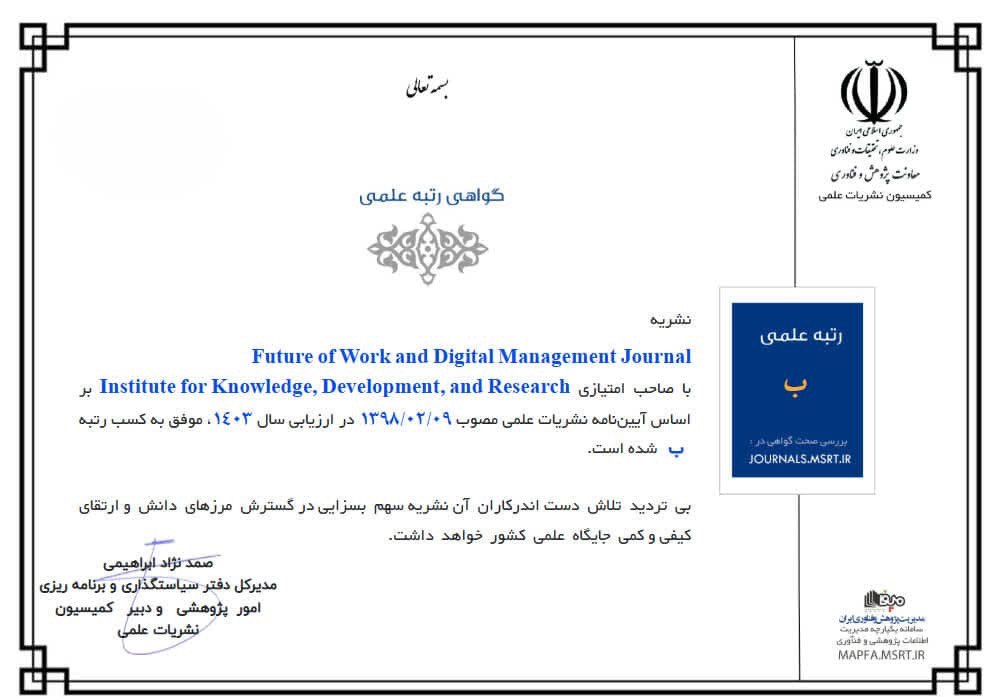Design and Development of an Insurance Industry Product Model Based on Artificial Intelligence, Blockchain, and the Internet of Things in Iran's Insurance Sector
Keywords:
Insurance Industry, Artificial Intelligence, Blockchain, Internet of Things (IoT)Abstract
The rapid advancements in emerging technologies—particularly artificial intelligence (AI), blockchain, and the Internet of Things (IoT)—have propelled the insurance industry toward unprecedented innovations and positioned InsurTech as a driving force in the reconfiguration of the insurance value chain. This study aimed to design and develop a product model for Iran’s insurance industry based on these transformative technologies. Employing a mixed-methods research approach (qualitative and quantitative), the study first extracted the initial indicators and components through systematic content analysis and semi-structured interviews with 15 experts in the insurance and information technology sectors. These qualitative data were analyzed using grounded theory via MAXQDA software. In the quantitative phase, a conceptual model was validated using a researcher-made questionnaire administered to a sample of 384 insurance industry customers. Data analysis was conducted using Structural Equation Modeling (PLS-SEM) via SmartPLS software. The findings revealed that emerging technologies significantly impact the performance of the insurance industry through four key components: AI-driven innovation in insurance products, blockchain-based transparency and security, IoT-based risk management and personalized services, and enhanced operational efficiency of insurance companies. The results suggest that by improving personalization, reducing costs, increasing transparency, and optimizing processes, these technologies not only enhance the operational and competitive efficiency of insurance firms but also improve customer experience and the overall sustainability of the industry. The study’s recommendations emphasize the development of innovative products, the strengthening of digital infrastructure, and the adoption of mobile applications for customer-oriented services and targeted advertising.
Downloads
References
[1] S. Ahmad, R. Karim, N. Sultana, and R. P. Lima, "InsurTech: Digital Transformation of the Insurance Industry," in Financial Landscape Transformation: Technological Disruptions: Emerald Publishing Limited, 2025, pp. 287-299.
[2] S. Cosma and G. Rimo, "Redefining insurance through technology: Achievements and perspectives in InsurTech," Research in International Business and Finance, 2024, doi: 10.1016/j.ribaf.2024.102301.
[3] S. Cosma and G. Rimo, "Fintech, financial inclusion, and social challenges: The role of financial technology in social inequality," in Fintech and Sustainability, 2023, pp. 107-128.
[4] I. S. Gómez and O. M. Pineda, "What is an InsurTech? A scientific approach for defining the term," Risk Management and Insurance Review, vol. 26, no. 2, pp. 125-173, 2023, doi: 10.1111/rmir.12243.
[5] A. Akhareti, "Insurance technology (InsurTech) and its impact on the insurance industry: A review of several companies," in National Conference on Interdisciplinary Research in Management and Humanities, Tehran, Iran, 2020.
[6] A. R. Zarrabiyeh, I. Arasto, and A. Jahedi, "Insurance startups and transformational innovation in the insurance industry," in 25th National Conference on Insurance and Development, Tehran, Iran, 2018.
[7] M. Palmié, J. Wincent, V. Parida, and U. Caglar, "The evolution of the financial technology ecosystem: An introduction and agenda for future research on disruptive innovations in ecosystems," Technological Forecasting and Social Change, vol. 151, 2020, doi: 10.1016/j.techfore.2019.119779.
[8] J. Liu, X. Li, and S. Wang, "What have we learnt from 10 years of Fintech research? A scientometric analysis," Technological Forecasting and Social Change, vol. 155, 2020, doi: 10.1016/j.techfore.2020.120022.
[9] L. Cao, Q. Yang, and P. S. Yu, "Data science and AI in Fintech: An overview," International Journal of Data Science and Analytics, vol. 12, pp. 81-99, 2021, doi: 10.1007/s41060-021-00278-w.
[10] S. Rawat, A. Rawat, D. Kumar, and A. S. Sabitha, "Application of machine learning and data visualization techniques for decision support in the insurance sector," International Journal of Information Management Data Insights, vol. 1, p. 100012, 2021, doi: 10.1016/j.jjimei.2021.100012.
[11] T. C. Yan, P. Schulte, and D. L. K. Chuen, "InsurTech and FinTech: Banking and insurance enablement," in Handbook of Blockchain, Digital Finance, and Inclusion, vol. 1: Academic Press, 2018, pp. 249-281.
[12] A. Bakhshayesh, "Developing the insurance industry using artificial intelligence and the Internet of Things," in 25th National Conference on Insurance and Development, Tehran, Iran, 2018.
[13] J. Liu, Ye, Shujun, Zhang, Yujin, Zhang, Lulu, "Research on InsurTech and the technology innovation level of insurance enterprises," Sustainability, vol. 15, no. 11, p. 8617, 2023. [Online]. Available: https://www.mdpi.com/2071-1050/15/11/8617.
[14] Z. Temelkov, "Fintech firms: Opportunity or threat for banks?," International Journal of Information Business Management, vol. 10, no. 1, pp. 137-143, 2018.
[15] Z. Khaki, A. Babaki Rad, and S. Khayyat Moghaddam, "Evaluating the impacts of artificial intelligence on innovation in the insurance industry," in 4th National Conference on Industrial Management and Industrial Engineering with Emphasis on Regional and Global Paradigms, Tehran, Iran, 2019.
[16] C. Barbara, D. Cortis, R. Perotti, C. Sammut, and A. Vella, "The European insurance industry: A PEST analysis," International Journal of Financial Studies, vol. 5, no. 2, p. 14, 2017, doi: 10.3390/ijfs5020014.
[17] M. Haghighi Kafash, A. Bahrami, and B. Hajikarimi, "Presenting an insurance technology (InsurTech) marketing model for startups in the insurance industry," Modern Marketing Research, vol. 12, no. 1, pp. 197-216, 2023.
[18] D. Pauch, Bera, Anna, "Digitization in the insurance sector – challenges in the face of the Covid-19 pandemic," Procedia Computer Science, vol. 207, no. no, pp. 1677-1684, 2022/01/01/ 2022, doi: 10.1016/j.procs.2022.09.225.
[19] K. Balaji and E. Ariwa, "Insurtech disruption: Reshaping the future of insurance in the fintech era," in The Adoption of FintechPB - Productivity Press, 2024, pp. 247-266.
[20] M. Bhattacharya and S. F. Wamba, "A conceptual framework of RFID adoption in retail using TOE framework," in Technology Adoption and Social Issues: IGI Global, 2018, pp. 69-102.
[21] D. Cortis, J. Debattista, J. Debono, and M. Farrell, "InsurTech," in Disrupting Finance: Palgrave Pivot, Cham, 2019, pp. 71-84.
[22] L. Lin and C. H. Christopher, "The promises and perils of InsurTech," Singapore Management University, 2020.
Downloads
Published
Submitted
Revised
Accepted
Issue
Section
License
Copyright (c) 2025 Laleh Chehreh , Seyyed Mohammad Reza Miri Lavasani, Fereydon Rahnamarodposhti , Jafar Jamali (Author)

This work is licensed under a Creative Commons Attribution-NonCommercial 4.0 International License.








